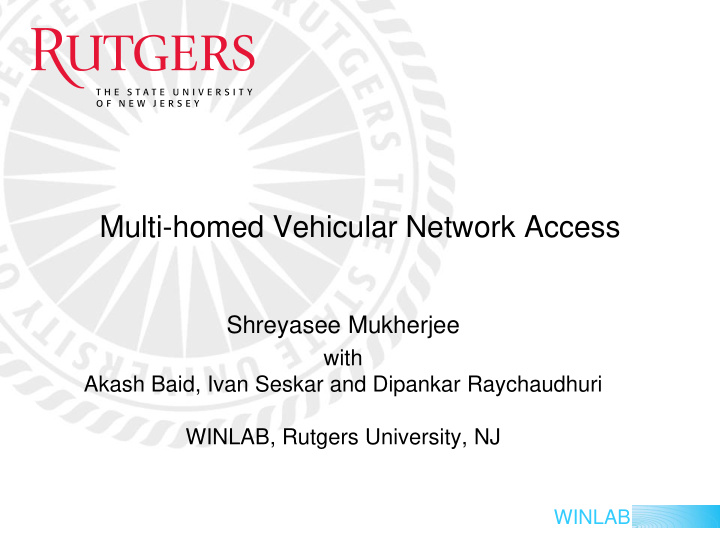



Multi-homed Vehicular Network Access Shreyasee Mukherjee with Akash Baid, Ivan Seskar and Dipankar Raychaudhuri WINLAB, Rutgers University, NJ WINLAB
Outline • Motivation • Available Technologies • Network Requirements • The MobilityFirst Architecture • Evaluation Use-cases • Conclusion 2 WINLAB
Motivation Connected Vehicles • Safety applications • Demand for maps and real-time traffic info • Increasing demand for infotainment based rich content delivery 3 WINLAB
Motivation Vehicular communication scenarios • Vehicles with infrastructure (V2I/I2V) • Vehicles with other vehicles (V2V) • In-car communication Focus Focus on on V2I/I2V V2I/I2V 4 WINLAB WINLAB
Available technologies • LTE • WiFi Coverage ǂ * Continuous coverage Good coverage but disconnection prone * Price Inexpensive Expensive Speed Rutgers wireless on a Macbook Pro AT&T LTE connection a Samsung Galaxy S4 5 WINLAB ǂ wigle.net * www.att.com
Multi-homed Access • How do we utilize both of these technologies simultaneously? • Network efficiently utilizing multi-interface capability to WiFi improve LTE user/network performance 6 WINLAB
Network requirements • Accurate link quality estimation • Data striping across multiple interfaces • DTN mode of operation • Seamless handoff 7 WINLAB
The MobilityFirst Architecture • Globally unique names (GUIDs) for network attached objects • Separation of names from network addresses • Storage-aware routing • Hop by hop reliable transport 8 WINLAB
Multi-homing in MobilityFirst NCS GUID 11011..011 Send (GUID = 11011..011, data) GNRS Server GNRS update (GUID 11011..011, NA99, NA32, Stripe) Send (GUID = 11011..011, NA 1 data striping uses a SID=01, NA99, NA32, data) Re � G Sender:� GUID X reliable backpressure NA 2 based mechanism 9 WINLAB
Evaluation Dual-homing (WiFi + LTE) with DTN • NS3 based simulations • MobilityFirst naming routing transport modeled • NS3’s WiFi and LTE modules used Radio Parameter Value MAC 802.11a (non QoS) • Multi-homed mobile client WiFi Propagation Log Distance Loss • Stable LTE coverage with lower data Rate Control Adaptive ARF rate • Intermittent WiFi coverage with DL & UL RBs 15 varying data rate MAC Proportional Fair LTE Scheduler Dl-30dBm, UL- Tx power 10 WINLAB 10dBm
Evaluation Throughput and delay metrics for dual-homing 450 200 use both WiFi and LTE use both WiFi and LTE use only WiFi use only WiFi 400 180 use only LTE use only LTE File Transfer Completion Time (secs) 160 350 Aggregate Throughput(MBytes) Aggregate throughput close 140 to the sum of the 300 throughput through each 120 250 100 200 80 150 60 No WiFi 100 connectivity 40 50 20 0 0 10 20 30 40 50 60 70 80 90 5meters/s(11mph) 10meters/s 20meters/s 30meters/s(67mph) Time(secs) Speed of Vehicle 11 WINLAB
Evaluation Realistic (multi-WiFi +LTE) access scenario • ~1X2 miles area of San Francisco • 30 open WiFi access points shown • Back-end LTE with base-station at the approximate center assumed • Actual cab traces in the area simulated 12 WINLAB
Evaluation Multi-homing throughput for cabs 70 70 Using only LTE Using the best available Wi-Fi 60 60 Maximum throughput per sec (in Mbps) Average throughput per sec (in Mbps) Using all the available WiFis Using all the Wi-Fis and LTE 50 50 40 40 30 30 20 20 10 10 0 0 1 2 3 4 5 1 2 3 4 5 Cab no. Cab no. Average and maximum throughput for continuous data transfer of 100 seconds 13 WINLAB
Conclusion • MobilityFirst features inherently supports multi-homing • Future research directions: Mobility prediction Probing for accurate Content server link quality estimation Improved transport Improved Inter-domain Multi-network Routing Content caching Access 14 WINLAB
Thank you! WINLAB
Extras 16 WINLAB
Planned WiFi hotspot deployment 17 WINLAB
Recommend
More recommend